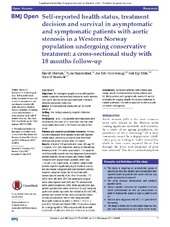| dc.contributor.author | Oterhals, Kjersti | en_US |
| dc.contributor.author | Haaverstad, Rune | en_US |
| dc.contributor.author | Nordrehaug, Jan Erik | en_US |
| dc.contributor.author | Eide, Geir Egil | en_US |
| dc.contributor.author | Norekvål, Tone M. | en_US |
| dc.date.accessioned | 2018-08-07T12:21:49Z | |
| dc.date.available | 2018-08-07T12:21:49Z | |
| dc.date.issued | 2017-08-21 | |
| dc.Published | Oterhals K, Haaverstad R, Nordrehaug JE, Eide GE, Norekvål TM. Selfreported health status, treatment decision and survival in asymptomatic and symptomatic patients with aortic stenosis in a Western Norway population undergoing conservative treatment: a cross-sectional study with 18 months follow-up. BMJ Open. 2017;7:e016489 | eng |
| dc.identifier.issn | 2044-6055 | |
| dc.identifier.uri | https://hdl.handle.net/1956/18018 | |
| dc.description.abstract | Objectives: To investigate symptoms and self-reported health of patients conservatively treated for aortic stenosis (AS) and to identify factors associated with treatment decision and patient outcomes. Design: A cross-sectional survey with an 18-month follow-up. Setting: One tertiary university hospital in Western Norway. Participants: In all, 1436 patients were diagnosed with AS between 2000 and 2012, and those 245 still under conservative treatment in 2013 were included in this study. Primary and secondary outcome measures: Primary outcome measures were symptoms and self-reported health status. Secondary outcomes were treatment decision and patient survival after 18 months. Results: A total of 136 patients with mean (SD) age 79 (12) years, 52% men responded. Among conservatively treated patients 77% were symptomatic. The symptom most frequently experienced was dyspnoea. Symptomatic patients reported worse physical and mental health compared with asymptomatic patients (effect size 1.24 and 0.74, respectively). In addition, symptomatic patients reported significantly higher levels of anxiety and depression compared with asymptomatic patients. However, symptom status did not correlate with haemodynamic severity of AS. After 18 months, 117 (86%) were still alive, 20% had undergone surgical aortic valve replacement (AVR) and 7% transcatheter aortic valve implantation (TAVI). When adjusting for age, gender, symptomatic status, severity of AS and European system for cardiac operative risk evaluation (EuroSCORE), patients with severe AS had more than sixfold chance of being scheduled for AVR or TAVI compared with those with moderate AS (HR 6.3, 95% CI 1.9 to 21.2, p=0.003). Patients with EuroSCORE ≥11 had less chance for undergoing AVR or TAVI compared with those with EuroSCORE ≤5 (HR 0.06, 95% CI 0.01 to 0.46, p=0.007). Conclusions: Symptoms affected both physical and mental health in conservatively treated patients with AS. Many patients with symptomatic severe AS are not scheduled for surgery, despite the recommendations in current guidelines. The referral practice for AVR is a path for further investigation. | en_US |
| dc.language.iso | eng | eng |
| dc.publisher | BMJ | eng |
| dc.rights | Attribution CC BY-NC | eng |
| dc.rights.uri | http://creativecommons.org/licenses/by-nc/4.0/ | eng |
| dc.title | Selfreported health status, treatment decision and survival in asymptomatic and symptomatic patients with aortic stenosis in a Western Norway population undergoing conservative treatment: a cross-sectional study with 18 months follow-up | en_US |
| dc.type | Peer reviewed | |
| dc.type | Journal article | |
| dc.date.updated | 2018-03-06T12:39:53Z | |
| dc.description.version | publishedVersion | en_US |
| dc.rights.holder | Copyright 2017 The Author(s) | |
| dc.identifier.doi | https://doi.org/10.1136/bmjopen-2017-016489 | |
| dc.identifier.cristin | 1552999 | |
| dc.source.journal | BMJ Open | |

